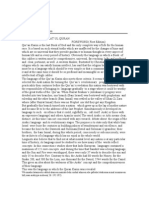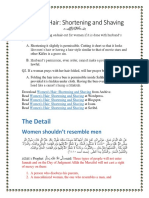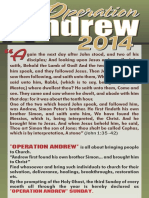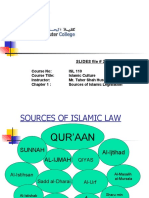Arabic Notes
Arabic Notes
Uploaded by
Mubasher GillaniCopyright:
Available Formats
Arabic Notes
Arabic Notes
Uploaded by
Mubasher GillaniOriginal Description:
Original Title
Copyright
Available Formats
Share this document
Did you find this document useful?
Is this content inappropriate?
Copyright:
Available Formats
Arabic Notes
Arabic Notes
Uploaded by
Mubasher GillaniCopyright:
Available Formats
I compiled this back in 2008, hope it'll help the new aspirants.
Ibn-e-manzoor:
His name is Abu al fazal zamal aldin muhammad bin mukaram bin ali bin ahmad al ansari al
afriqi and almisri. He is of arab origion having his family roots associated with rufie^ bin
thabit alansari.
.
Life history:
cuz I have no idea),in the holy month of muharram in year 630H, 1232 A.D. he belonged to
shia^ school of thought, though its disputed. He saw many seasons of life, many years of
struggle and devotion. He was the finest intellectual of his times, who was aware of the
universal facts and I feel no hesitation to say that he reserves the right of being called the
esteem of Arabic heritage. He was a scholar and mastered in many fields,He was born in
cairo, some say in tarablus(please confirm where does this exists most notable, law,
linguistics, history, grammar and literature. He also showed his extraordinary abilities in
writing prose and rhythmic poems. His abilities lead him to the highest designation of
judge in tarablus. He also worked in diwan-e-insha for a long time. Despite of his legal
affairs, he spent a lot of time in reading Arabic literature and research in arabic linguistics.
Most of his work is based on translation and summarizing the bulk of arabic literature so as
to make it handy for a common reader.
According to al-safdii, I dont know any one except him who had summarized the huge
books as his son, qutub al din has narrated that he has left behind him 5000 volumes of
manuscripts written by himself. He summarized one fourth of tareekh-e-damishk..
His other summarized works are as follows:
Mukhtasir alagani
10 volumes of mukhtasir tareekh bagdad by khateeb al bagdadi. " "
.
Mukhtasir tareekh damishk by ibn-e-asakar " "
// mufridat ibn al bitar "
// al haiwan by al jahiz " "
// zahr aladab by hasri " "
// yateema al dahar by al thalabi " "
" " .
" "
Death:
In the last days of his life, though he lost his sight, he was a man of high wisdom, nobility
and origionality.he died in egypt in the month of shaban in 711 H , 1311A.D. thus the
islamic throne lost one of its most precious gems.
Lisan Al Arab
(it consists of 80000 letters having 20 volumes originally. Its more likely to be called an
encyclopedia of language than just a mere dictionary)
His most celebrated work is lisan al Arab which is considered to be the magnum opus of the
time because it not only provides a mature outlook on the Arabic language but also helps a
non Arab to admire the beauty of the eloquence and richness of this literature.
Motive behind the tome:
He had the following motives for writing such a voluminous book:
1. In his times there was a massive research going on the arabic literature. Scholars from
other parts of the world were coming to arabic regions in order to learn arabic. Many of
them translated the A.literature into their own languages but doing so they deprived it of its
sanctity and originality. Ibne manzoor foresighted the devaluation of Arabic language. He
divided his contemporary writers into two groups namely:
Those who know hoe to put things(yahan matlab hai k tarteeb sahi nahi thi us waqt k ulema
ne information ki tarteeb mein bohot galatian kien jo k aam logon ke liyay samajhna
mushkill tha.e.g A was discussed after C and T was discussed after B) but lack the skill of
compiling them
Those who know the compilation but lack the ability to put the information in its proper
place.
According to him, what is compilation without the art of putting them rightly? and what is
the art of adjustment without the skill of compilation?
2. confirming the importance of Arabic language and that this is the sacred, miraculous
language with many attributes within it, he wrote his master piece in order to unveil the
grandeur to the world. He wanted to preserve the rich heritage which this language holds in
it self, for thousands of years. He says himself in the foreword of his book LISAN AL ARAB,
this language of Arabia has been esteemed with the eloquence over all the other languages
and the fact, that its the language in which Quraan has been revealed and the language of
the people of jannah, preserves its value. As prophet said, love the arab for three reasons
:1) I am Arab, 2)Quraan is in Arabic 3)it is the language of the people of paradise.
3. he said in the foreword that he has not intended other than to preserve the origin of this
prophetic language.. because he saw it overpowered by other races ,because of racial and
language differences. The translations into ajami languages and awful changes in the dialect
has forced him to write something that would introduce the readers with the original
prophetic language, so as to preserve the language Arabs are proud of.
Method used in the book:
1) this book is actually a compilation of the five famous books of Arabic language before
ibne manzoor. He has made an encyclopedia for the ulema of literature, tafseer, hadith and
fiqh.He has combined together the following books, taking the most comprehensive ideas
and examples to clarify or explain a certain word or letter:
i) Tahzeeb al luga by alazhari
ii) Al mauhkim by ibn said
iii) Al sahah by al jawhari
iv) Hashiah al sahah by ibn bri
v) Al nahaya fi gareeb al hadith by ibn athir
vi) Jmhra tul luga by ibn dareed
2) The sequence or tarteeb of the chapters and subchapters are according to al sahah by
aljawhari.
3) All the chapters are being placed in a way to confirm that their placement doesnt
contradicts with the grammatical or other literary rules. Every word and detailed have been
compiled with due concentration so as not to lead the reader away from the usul of this
language.
4) Every word has an explanation from Quraan alkarim and hadith.
5) Every word has been explained through examples, proverbs, prose and poetic stanzas.
6) The literal meanings of the words are explained in connection to the philosophical use as
well.
7) It contains at least two pages of forward and then he starts with the name of Allah.
8) The book starts with the name of Allah and all praise to Allah. Then the writer thanks
Allah for His help in the writing of this master piece. Also he explains the importance of
Arabic language and praises it, in order to prepare the readers mind to absorb the
sacredness of this language.
9) he criticizes the works Tahzeeb al luga by alazhari, Al mauhkim by ibn said, Al sahah by
al jawhari, and rewrite their information in a more sequenced manner.
10) Then in-between the dictionary and the forward he has placed two chapters about the
explanation of miraculous letters ( haruf al muqattaa, the 1st letter of the surah e.g ) and
traits of the words used in the book.
11) He defines the origin of the word, its characteristics, types, grammatical differences etc.
12) He ends the book in a most beautiful manner that may Allah exalt the value of this book
and this language and that may many be benefited by this book and may it help the ulema
in increasing their wisdom and may the people of jannah talk in this dialect.
13) The book has been published in Cairo having 20 volumes, each with more than 300
pages.
14) One of the important things to mention is that to find a word we have to see the last
letter of the word. So for example if the word ends with such as , we will find the word
in 2nd chapter of the book i.e. . The book has been written alphabetically.
You might also like
- Know Yourself: An Explanation of the oneness of beingFrom EverandKnow Yourself: An Explanation of the oneness of beingCecilia TwinchRating: 4.5 out of 5 stars4.5/5 (9)
- Firdaus Al - Ikma Fī ' - IbbDocument706 pagesFirdaus Al - Ikma Fī ' - IbbBrian Phillips100% (3)
- The Maqamat of Badi Al Zaman Al HamadhaniDocument199 pagesThe Maqamat of Badi Al Zaman Al Hamadhanibanarisali100% (4)
- Advanced Arabic Grammar BookDocument80 pagesAdvanced Arabic Grammar Bookhyalinmaganda75% (4)
- Al-Muqaddimah Al-Ajurrumiyyah Translated by Amienoellah AbderoefDocument62 pagesAl-Muqaddimah Al-Ajurrumiyyah Translated by Amienoellah Abderoefadambridger100% (1)
- AL-AJURRUMIYYAH Trnslation in EnglishDocument64 pagesAL-AJURRUMIYYAH Trnslation in Englishrahma786No ratings yet
- Doctrine Study GuideDocument16 pagesDoctrine Study GuideEdward Wu100% (1)
- Pre-Islamic Arabic and The Language of The Qur AnDocument6 pagesPre-Islamic Arabic and The Language of The Qur AnRao Behram0% (1)
- Handbook of Arabic DictionariesDocument63 pagesHandbook of Arabic DictionariesRamy Al-Gamal100% (1)
- Arabic Grammar Book 1Document71 pagesArabic Grammar Book 1Denisa CretuNo ratings yet
- Hassan ibn Thabit: An Original Arabic Tongue (2) - حسان بن ثابت: لسان عربي أصيلDocument12 pagesHassan ibn Thabit: An Original Arabic Tongue (2) - حسان بن ثابت: لسان عربي أصيلYahya Saleh Hasan Dahami (يحيى صالح دحامي)No ratings yet
- Arabic Grammar BookDocument80 pagesArabic Grammar BookyazadnNo ratings yet
- A Hundred and One Rules of Arabic GrammarDocument80 pagesA Hundred and One Rules of Arabic Grammarparb33No ratings yet
- University of Kashmir: "Language and Literature of Jāhilīyyah Arabia''Document10 pagesUniversity of Kashmir: "Language and Literature of Jāhilīyyah Arabia''kifaitullah000No ratings yet
- 101 Rules in Arabic GrammarDocument69 pages101 Rules in Arabic GrammarAmma Hawa100% (7)
- Literature Review ArabicDocument6 pagesLiterature Review Arabicaflsqfsaw100% (1)
- Lughat Ul QuranDocument6 pagesLughat Ul QuranShahzad ShameemNo ratings yet
- The Essence of Al-Balāghah (Rhetoric) To Arabic and Yoruba LanguagesDocument5 pagesThe Essence of Al-Balāghah (Rhetoric) To Arabic and Yoruba LanguagesEridy EridyNo ratings yet
- Konfigurasi Kalimat Bijak Dan Indah Dalam Kitab Husnus SiyaghohDocument11 pagesKonfigurasi Kalimat Bijak Dan Indah Dalam Kitab Husnus SiyaghohNanang Abdul AzizNo ratings yet
- THE of Ibn: (Izahw), AlfiyyaDocument6 pagesTHE of Ibn: (Izahw), AlfiyyaAmàr AqmarNo ratings yet
- Lughaat Al Quran G A ParwezDocument736 pagesLughaat Al Quran G A Parwezscholar786No ratings yet
- Arabic Linguistics and SibawaihiDocument9 pagesArabic Linguistics and Sibawaihiasasha88No ratings yet
- ARABIC SEC 101, FYUG AUS, UNIT-IIDocument4 pagesARABIC SEC 101, FYUG AUS, UNIT-IIallindiaislamictvNo ratings yet
- An Nida Theory According To The PerspectDocument10 pagesAn Nida Theory According To The PerspectruqaiyashmohammadNo ratings yet
- 10 1163@9789004343047 PDFDocument527 pages10 1163@9789004343047 PDFManticora VenerabilisNo ratings yet
- The Influence of Ibrahim Khafaji as Arabic Lyric Poet - تأثير إبراهيم خفاجي: شاعر القصيدة الغنائية العربيةDocument18 pagesThe Influence of Ibrahim Khafaji as Arabic Lyric Poet - تأثير إبراهيم خفاجي: شاعر القصيدة الغنائية العربيةYahya Saleh Hasan Dahami (يحيى صالح دحامي)No ratings yet
- IJAR2Document9 pagesIJAR2muhammadabubakar666No ratings yet
- Balagh Ul QuranDocument15 pagesBalagh Ul QuranRana Mazhar67% (3)
- Arabic LiteratureDocument4 pagesArabic LiteratureFaith Clavaton MoralesNo ratings yet
- Arabic Proverbs (Old Book)Document100 pagesArabic Proverbs (Old Book)DJVLADIMIR7100% (1)
- ArabicDocument7 pagesArabicsroterbiporitNo ratings yet
- Al-Muqaddimah Al-Ajurrumiyyah Translated by Amienoellah AbderoefDocument65 pagesAl-Muqaddimah Al-Ajurrumiyyah Translated by Amienoellah AbderoefOmer SultanNo ratings yet
- Al-Muqaddimah Al-Ajurrumiyyah Translated by Amienoellah AbderoefDocument72 pagesAl-Muqaddimah Al-Ajurrumiyyah Translated by Amienoellah AbderoefaemNo ratings yet
- The Arabic language Second Edition Kees Versteegh & C. H. M. Versteegh 2024 scribd downloadDocument81 pagesThe Arabic language Second Edition Kees Versteegh & C. H. M. Versteegh 2024 scribd downloadmosfiqcoconiNo ratings yet
- KashfDocument879 pagesKashfSoak Kaos100% (5)
- My Introduction by Mr. David Rosenbaum of New York TimesDocument12 pagesMy Introduction by Mr. David Rosenbaum of New York TimesMohammed Abdul Hafeez, B.Com., Hyderabad, IndiaNo ratings yet
- Art 14Document12 pagesArt 14Hasan TariqNo ratings yet
- Arabic (36) : Ntroduction General ObjectivesDocument2 pagesArabic (36) : Ntroduction General Objectivesngwenping5No ratings yet
- Al Ajeruumiya Arabic and EnglishDocument36 pagesAl Ajeruumiya Arabic and EnglishzoussamadoNo ratings yet
- The Influence of The Arabic Language: The Muwashshah of Ibn Sahl Al-Andalusi An ExampleDocument8 pagesThe Influence of The Arabic Language: The Muwashshah of Ibn Sahl Al-Andalusi An ExampleAJHSSR JournalNo ratings yet
- The Influence of The Arabic Language: The Muwashshah of Ibn Sahl Al-Andalusi An ExampleDocument8 pagesThe Influence of The Arabic Language: The Muwashshah of Ibn Sahl Al-Andalusi An ExampleYahya Saleh Hasan Dahami (يحيى صالح دحامي)No ratings yet
- GRD271-Islamic EN-Lec11-Contributions-Part2Document13 pagesGRD271-Islamic EN-Lec11-Contributions-Part2attooNo ratings yet
- Tarafah Ibn Al-A'bd and His Outstanding Arabic Mua'llagah: Yahya Saleh Hasan DahamiDocument9 pagesTarafah Ibn Al-A'bd and His Outstanding Arabic Mua'llagah: Yahya Saleh Hasan DahamiIJELS Research JournalNo ratings yet
- Arabic LiteratureDocument30 pagesArabic Literaturemuhammad abid manzoor malghaniNo ratings yet
- The Importance of Arabic Language To Research Efforts in Islamic Studies Otuyo, Ibrahim JamiuDocument14 pagesThe Importance of Arabic Language To Research Efforts in Islamic Studies Otuyo, Ibrahim JamiuDunia “Mr Radux” Lucu0% (1)
- Introduction Arabic As A South Asian LanguageDocument16 pagesIntroduction Arabic As A South Asian LanguageAshir BeeranNo ratings yet
- Arabic GemsDocument69 pagesArabic GemsfirasmaxNo ratings yet
- Rhetorical Means in A Didactic Amharic PoemDocument28 pagesRhetorical Means in A Didactic Amharic PoemFatehMoussaNo ratings yet
- Introduction Literature - PERIODIZATION OF THE DEVELOPMENT OF ARABIC LITERATUREDocument11 pagesIntroduction Literature - PERIODIZATION OF THE DEVELOPMENT OF ARABIC LITERATUREMylestari OfficialNo ratings yet
- Arnold (Ed.) - Legacy of Islam (1931)Document294 pagesArnold (Ed.) - Legacy of Islam (1931)Mouka ZwinaNo ratings yet
- Selections from The Art of Party Crashing in Medieval IraqFrom EverandSelections from The Art of Party Crashing in Medieval IraqRating: 3.5 out of 5 stars3.5/5 (4)
- Night & Horses & The Desert: An Anthology of Classic Arabic LiteratureFrom EverandNight & Horses & The Desert: An Anthology of Classic Arabic LiteratureNo ratings yet
- The Iranian Talmud: Reading the Bavli in Its Sasanian ContextFrom EverandThe Iranian Talmud: Reading the Bavli in Its Sasanian ContextRating: 2.5 out of 5 stars2.5/5 (2)
- Arabs and the Art of Storytelling: A Strange FamiliarityFrom EverandArabs and the Art of Storytelling: A Strange FamiliarityNo ratings yet
- William Shakespeare 2012 1 PDFDocument471 pagesWilliam Shakespeare 2012 1 PDFMubasher GillaniNo ratings yet
- Pak Us RelationDocument2 pagesPak Us RelationMubasher GillaniNo ratings yet
- Arabic Paper II 2014Document1 pageArabic Paper II 2014Mubasher GillaniNo ratings yet
- ArabicDocument10 pagesArabicMubasher GillaniNo ratings yet
- The Silent Quran and The Speaking QuranDocument32 pagesThe Silent Quran and The Speaking QuranMuhammad HareesNo ratings yet
- Women's Hair: Shortening and ShavingDocument7 pagesWomen's Hair: Shortening and ShavingmusarhadNo ratings yet
- Metode Dakwah Dalam Al-Qur'An (Studi Penafsiran Hamka Terhadap QS. An-Nahl: 125) A. M. IsmatullohDocument15 pagesMetode Dakwah Dalam Al-Qur'An (Studi Penafsiran Hamka Terhadap QS. An-Nahl: 125) A. M. IsmatullohFirdaus CanNo ratings yet
- Abu Basir Al-Asadi - WikipediaDocument3 pagesAbu Basir Al-Asadi - WikipediaMuzammil RizviNo ratings yet
- 04/04/2010 Mass ReadingsDocument2 pages04/04/2010 Mass ReadingsgimjemassNo ratings yet
- 20529954-Sman 1 Sumenep-201911080657Document45 pages20529954-Sman 1 Sumenep-201911080657Mass YogaNo ratings yet
- Creation of Universe An Islamic PerspectiveDocument3 pagesCreation of Universe An Islamic PerspectiveassadNo ratings yet
- Operation Andrew 2014Document2 pagesOperation Andrew 2014Benjamin Afrane NkansahNo ratings yet
- Being A ServantDocument2 pagesBeing A ServantekyllbayanNo ratings yet
- Prayer For The Repose Booklet Roman ManaladDocument12 pagesPrayer For The Repose Booklet Roman Manaladjoy in the spirit of the lord100% (1)
- Hadis Tarbawi IiDocument18 pagesHadis Tarbawi Iinlinda amaliaNo ratings yet
- Abbott Decline of The Mughal Empire and Shah Waliullah PDFDocument10 pagesAbbott Decline of The Mughal Empire and Shah Waliullah PDFBlanca BryantNo ratings yet
- The Qatabre Sheikh, Mawlid Celebration and Intra-Faith Debate On The Mawlid CelebrationDocument128 pagesThe Qatabre Sheikh, Mawlid Celebration and Intra-Faith Debate On The Mawlid CelebrationAnwar Dureso100% (1)
- A Brief Biography of Hazrat Syed Shah Abdul Lateef Laubali Sahib KurnoolDocument6 pagesA Brief Biography of Hazrat Syed Shah Abdul Lateef Laubali Sahib KurnoolMohammed Abdul Hafeez, B.Com., Hyderabad, IndiaNo ratings yet
- Pak Studies Notes by Hassan Askari: Social Change (International Islamic University Islamabad)Document3 pagesPak Studies Notes by Hassan Askari: Social Change (International Islamic University Islamabad)faraz aziz0% (1)
- Codifying Gilchrist's Errors Over Ibn Mas'ud's CodexDocument33 pagesCodifying Gilchrist's Errors Over Ibn Mas'ud's CodexAndy مسافر OvensNo ratings yet
- 1alquran 2sunnan 3alijma 4alijtehad 5alqiyas 1207492409858775 9Document33 pages1alquran 2sunnan 3alijma 4alijtehad 5alqiyas 1207492409858775 9ahmed12588No ratings yet
- Aalahazrat, Imam Ahmed Raza Khan (Radi Allahu Ta'Ala Anhu) 'S Standard of Respect To SayyidsDocument3 pagesAalahazrat, Imam Ahmed Raza Khan (Radi Allahu Ta'Ala Anhu) 'S Standard of Respect To SayyidsGulam-I-Ahmed RazaNo ratings yet
- A Gift To Muslim LadiesDocument84 pagesA Gift To Muslim LadiesUddin Nimat100% (1)
- He Chose MeDocument1 pageHe Chose MeDerek Prince DignosNo ratings yet
- Mawlana Shaykh Nazim Al-Haqqani: Home Nur MuhammaDocument4 pagesMawlana Shaykh Nazim Al-Haqqani: Home Nur MuhammadamuNo ratings yet
- Commentary of Quran PDFDocument2 pagesCommentary of Quran PDFCraigNo ratings yet
- The Gospels: Lesson GuideDocument25 pagesThe Gospels: Lesson GuideCláudio César GonçalvesNo ratings yet
- Khazarian Jews Not The Seed of AbrahamDocument3 pagesKhazarian Jews Not The Seed of AbrahamMichael Jones100% (2)
- Imam Al SadiqDocument259 pagesImam Al Sadiqwww.alhassanain.org.englishNo ratings yet
- Azuza StrettDocument30 pagesAzuza Strettsamuel080No ratings yet
- Quran and Sunnah As Source of KnowledgeDocument9 pagesQuran and Sunnah As Source of KnowledgeKevser UnalNo ratings yet
- FOCUS April 2017 - Special Issue Dedicated To Chrysostom Valiya MetropolitanDocument25 pagesFOCUS April 2017 - Special Issue Dedicated To Chrysostom Valiya MetropolitanFOCUSNo ratings yet
- Curriculum Vitae Wouter Droppers 2021Document2 pagesCurriculum Vitae Wouter Droppers 2021ntalashaaNo ratings yet





























































































